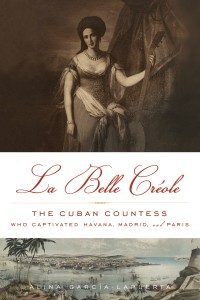La Belle Creole: Cuba’s earliest Female Author
Alina García-Lapuerta is the biographer of María de las Mercedes de Santa Cruz y Montalvo (often called La Belle Créole), Cuba’s earliest female author. What does writing a biography involve? We asked her.
How do you decide to recreate someone’s life? What drives you down a path that twists and turns and often leads to dead ends? Writing a historical biography means piecing together a life – from a distant perspective – blindly gathering up the scattered remnants and struggling to discover insights as to why/how/where. It’s arduous enough to understand the inner life of a close friend – interpreting a total stranger multiplies the difficulties. But sometimes a spark ignites that you can’t ignore.
In my case, the spark ignited with a description in a lovely illustrated book on Havana, which used the term “Cuban Scheherazade” to describe a nineteenth-century chronicler of colonial society. I had never heard of this mysterious Cuban-born Parisian countess Merlin who sailed into Havana in 1840 after an absence of nearly forty years. Even the name of her book, Viaje a La Habana (Voyage to Havana) conjured up images of sailing ships and times long gone. Who was Mercedes Santa Cruz y Montalvo?
University libraries yielded her memoirs, old biographies and articles which described her early Cuban childhood, life in Napoleonic Spain and in Louis-Philip’s Paris, where she captivated society with her angelic voice and hosted the city’s premier musical salon. I also found endless contradictory facts and seemingly fantastical claims.
I asked older Cuban relatives what they knew. Some answered: “yes, of course, we used to hear about her, but I can’t remember why.” Later, I found evidence of this vague, communal memory when a friend showed me a glamorous 1940s photo of his mother dressed as the “Condesa de Merlin” at a private Havana club to mark the 100th anniversary of the publication of Viaje a la Habana.
Despite the faded communal memory, Mercedes’ voice still came through powerfully in her writings. Her story seemed particularly gripping, encapsulating as it did so many human emotions and universal themes: the need to recreate oneself in a new world and the longing for one’s earliest roots. Mercedes seemed a passionate, romantic woman led by her heart, but prosaic enough to use the talents and opportunities available to salvage something from political upheaval and near financial ruin.
She lived in an age when women relied on their husbands and families, yet she eventually took charge of her fate, demonstrating an incredibly modern spirit. She escaped their shadow to forge her own destiny as Cuba’s earliest female writer and the patroness of countless artistic talents in Paris.
 Mercedes’ life clearly resonated, but transforming it into a biography was an ambitious task involving three countries, two languages and countless other challenges. I was fortunate that others had preceded me. One earlier (and similarly obsessed) biographer spent over thirty year tracking any related document. Another one had found Mercedes’ newlywed love letters in Madrid’s Rastro (flea market). No originals survive, but luckily published versions remained.
Mercedes’ life clearly resonated, but transforming it into a biography was an ambitious task involving three countries, two languages and countless other challenges. I was fortunate that others had preceded me. One earlier (and similarly obsessed) biographer spent over thirty year tracking any related document. Another one had found Mercedes’ newlywed love letters in Madrid’s Rastro (flea market). No originals survive, but luckily published versions remained.
In Havana, Madrid and Paris official archives and libraries contained legal documents, military records, wills, a treasure trove of letters and countless other pieces of paper. The period Mercedes lived in also benefited from the popularity of memoirs, gossipy newspaper accounts and musical and literary journals describing the vibrant Parisian artistic scene. All helped flesh out the sparkling world she inhabited.
Tracking down the actual sources sometimes required luck and instinct rather than specific knowledge. Archival sources in Cuba often had scanty summaries, so one could only guess whether it was worthwhile plowing through, but they sometimes yielded gold. Long held family secrets, surprising demonstrations of eighteenth-century love, poignant petitions demanding freedom for slaves – all filed under deceptively bland headings.
Roadblocks at times formed over trivial items such as the location of her 1809 marriage to a French general. My friend María volunteered to visit all the historic churches of Old Madrid, focusing on those near Mercedes’ home on Calle de la Luna and using a clue gleaned from a baptismal registry. Finally, we narrowed in on San Martín, now located near her old home. But wait! Back in 1809, Joseph Bonaparte had ordered the original church demolished and the parish had no fixed home.
María ultimately found the answer in the historic diocesan archives: Mercedes and her sister were married in their own home, but the marriage was registered in this wandering parish. Similar issues arose for her mother’s funeral and her daughter’s baptism. Madrid holds tightly to its mysteries, but María hounded every parish priest within a radius of the royal palace – never taking their inevitable “no” for a final answer!
The most frustrating mystery lay in understanding Mercedes’ Cuban inheritance and a long-running dispute with her brother – rumored to be the reason for her 1840 trip. Wading through countless Cuban and Spanish records yielded pieces of the puzzle, but not the solution. The final clue emerged, rather surprisingly, from the French National Archives. Leading back to long forgotten files in the Havana archives, this transatlantic solution came rather late in the writing process, but when it appeared it tied up so many loose ends.
Finding Mercedes’ descendants proved a final twist – and rather telling about how women were viewed in the nineteenth century. Almost every older Cuban source implies that Mercedes’ descendants died out with her grandson, Michel Merlin. But forgotten are her daughter Teresa’s six children. Through Teresa’s offspring, Mercedes has descendants in France today who proudly embrace her memory. What does this omission say about how women often lie hidden in the shadows?
All the more reason to remember, recreate and celebrate a vibrant life lived straddling cultures and leaving a rich transatlantic legacy.
La Belle Créole: The Cuban Countess Who Captivated Havana, Madrid, and Paris is out in September. To pre-order click here
—
Alina García-Lapuerta, a native Spanish speaker, was born in Cuba. A graduate of Georgetown University’s School of Foreign Service and Tufts University’s Fletcher School of Law and Diplomacy, she is member of Biographers International Organization, and The Biographers’ Club of London. Based in London with her Spanish-American husband and their two children, Alina still spends considerable time in South Florida.
Find out more about Alina on her site www.alinagarcialapuerta.com
Follow her on twitter @GarciaLapuerta and Facebook Alina-Garcia-Lapuerta
Category: Contemporary Women Writers, On Writing



























Looking forward to La Belle Creole’s September release!
One of the gifts of being a writer is recognizing when you’ve stumbled on a story that begs to be told. And researching the life of someone so fascinating, daunting as the process often is, has to double the joy of discovery that is goes hand-in-hand with the very act of writing. Will be looking forward to reading all about La Belle Creole.
You are absolutely right, Deborah. I have so enjoyed researching this book and putting together all the pieces to recreate her life. Crafting a story (fiction or non-fiction) is a journey of discovery and I feel privileged to have been on it!
A dauntful task you pursued with determination and rigour. Only SHE can appreciate the extra steps you took, as a woman, historian, biographer, to embrace the true life of Mercedes..
Thanks for giving us insights into female authors, past and present. I think valuing women’s stories starts with telling them. This particular figure, the Condesa, lived such a fascinating life. I was lucky to see some early drafts of this manuscript, and can’t wait to see the book in print because the writing is beautiful and the story larger than life.